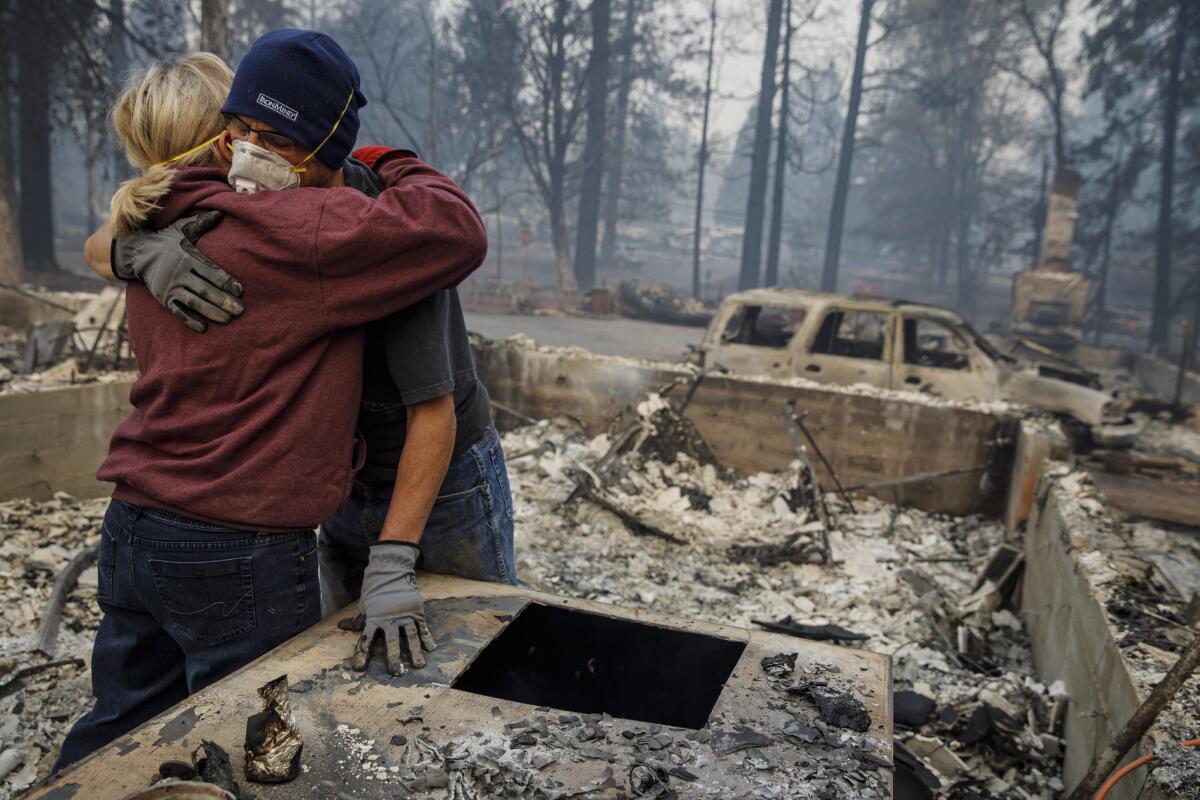PG&E’s $11-billion settlement with insurers sets up a clash with fire victims

- Share via
Bankrupt California utility giant PG&E Corp. resolved a key battle by agreeing to pay $11 billion to settle insurance claims from wildfires blamed on its equipment. An even bigger struggle looms.
The settlement with insurance carriers and investors, announced Friday, puts to rest a dispute with a group holding about 85% of insurance claims PG&E faces from deadly blazes in 2017 and 2018. The coalition, which includes Seth Klarman’s Baupost Group, had sought to wrest control of PG&E’s bankruptcy by presenting its own reorganization plan.
Shares of PG&E, the parent company of Pacific Gas & Electric Co., climbed 10.7% to $11.18 on news of the agreement, which still needs approval from the Bankruptcy Court.
Although the move is a step forward for PG&E, the utility faces an even more crucial negotiation with thousands of wildfire victims who lost homes, businesses or loved ones and claim they’re owed about $40 billion. PG&E has proposed capping those payouts at $8.4 billion.
A spokesman for fire victims blasted the utility’s settlement with insurance companies.
“This is just a blatant move on their part to help wealthy hedge funds and Wall Street,” said Patrick McCallum, co-chair of wildfire victims group Up From the Ashes. “They are more worried about their stock price and the hedge funds that hold their stock than the victims.”
The individual fire victims’ claims are pending in state and federal court. They could take months to resolve.
A PG&E spokeswoman called the settlement “another step” toward honoring the utility’s commitments to those affected by wildfires. “We remain committed to working with the individual plaintiffs to fairly and reasonably resolve their claims and will continue to work to do so,” Lynsey Paulo said.
A PG&E effort to ask the California Legislature to help the company pay off wildfire claims fell flat this year at the state Capitol.
PG&E filed for Chapter 11 bankruptcy protection in January, facing billions of dollars in liabilities from wildfires, blamed on the company’s equipment, that devastated parts of Northern California in 2017 and 2018. The fires killed more than 100 people and destroyed tens of thousands of structures.
The $11 billion that PG&E is agreeing to pay the insurance companies includes liabilities from the deadly 2017 Tubbs fire that raged in California’s wine country, a utility spokeswoman said. The total settlement exceeds the $8.5 billion that PG&E proposed for insurance claims in the reorganization plan it filed this week. The company now plans to file a revised plan with the Bankruptcy Court.
The deal is apt to strengthen PG&E’s control over its bankruptcy, said Negisa Balluku, a Bloomberg Intelligence litigation analyst. “The settlement, however, leaves open questions of wildfire victim recoveries,” she said in a research note.
The associated insurance carriers and investors claim that PG&E owes them a total of $20 billion. In a statement, the group said it “hopes this compromise will pave the way for a plan of reorganization that allows PG&E to fairly compensate all victims and emerge from Chapter 11 by the June 2020 legislative deadline.”
Baupost stands to gain at least $570 million from the settlement. In November, the firm bought $1 billion in legal claims that insurers held against PG&E, paying about 35 cents on the dollar, people familiar with the matter said. The settlement Friday implies a payout of roughly 55 cents on the dollar for Baupost, which is also PG&E’s third-largest shareholder.
The agreement is PG&E’s second major settlement of wildfire claims. In June, the company reached a $1-billion deal with 18 towns and other local governments to settle claims stemming from fires in 2015, 2017 and 2018.
Chediak and Deveau write for Bloomberg.
More to Read
Inside the business of entertainment
The Wide Shot brings you news, analysis and insights on everything from streaming wars to production — and what it all means for the future.
You may occasionally receive promotional content from the Los Angeles Times.











